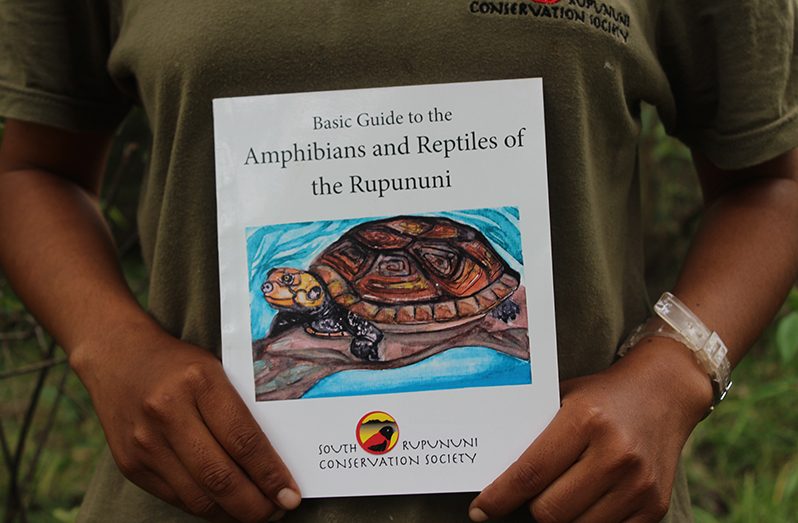– focuses on species of amphibians, reptiles
THE South Rupununi Conservation Society (SRCS) recently released its newest publication, “Amphibians and Reptiles of the Rupununi” created in collaboration with ReWild and Caiman House.
The authors are Neal Millar, Andrew Snyder, Rudolph Roberts Jr., and Nicholas Cyril.
According to Neal Millar, Programme Coordinator of SRCS, this book contains many species of amphibians and reptiles of the Rupununi, including the Black Caiman, the Giant Amazon River Turtle, and the Bushmaster.
“The book contains information on the scientific name, the common name, the Makushi and Wapichan names, and information about their habitats, how to identify them and their IUCN (International Union for Conservation of Nature) status,” he said.
It also contains information about how to identify venomous snakes; why some snakes change the colour of their skin, and adaptations in frogs.
A previously released book, the publication of the Mammals of the Rupununi as well as Amphibians and Reptiles of the Rupununi books was supported by the Sustainable Wildlife Management (SWM) Programme in Guyana, an initiative of the Organisation of African, Caribbean and Pacific States (OACPS), which the European Union funds with co-funding from the French Facility for Global Environment (FFEM) and the French Development Agency (AFD).
The books have been distributed to communities across the Rupununi for free, and residents have found them very useful for learning the local names of the species and for teaching their children about the wildlife of the Rupununi.
The SRCS, according to Millar, is proud that communities now have a resource to preserve this information.
“The organization also hopes to distribute these books across Guyana and to help other regions to produce similar books to educate residents on the amazing wildlife that is found in Guyana,” he said.
He added that the SRCS plans to sell these books in the future to raise funds for their important conservation work to residents of Guyana, tourists, and abroad.
“The next books in the series that SRCS are working on are Fish of the Rupununi, Plants of the Rupununi and Birds of the Rupununi Volume 2. If persons are interested in more information about the books, they can email srcs.rupununi@gmail.com,” Millar related.
Since the formation of SRCS in 2002, its members have been aware that knowledge about local wildlife in the Rupununi is less prevalent than it used to be.
Millar stated that their members particularly noticed that children in the Rupununi only know a few of the wildlife species that surround them despite living close to them.
“For example, while many children know about jaguars, they are unaware that there are five other types of wild cats that can be found in the Rupununi – the puma, the jaguarundi, the ocelot, the margay and the oncilla,” he explained.
Further, SRCS members were concerned that if the youngest generation is not knowledgeable about their local wildlife, they will be unable to manage it sustainably.
“SRCS members have also become aware that knowledge about the names of local wildlife in the local Wapichan and Makushi languages is being lost. There are, therefore, many people, particularly youths, who do not know the local names for many local species of wildlife,” he said.
Millar added: “As such, if this information is not preserved for future generations, then the culture of the Wapichan and Makushi people of Guyana will be negatively impacted.”
To resolve this, the SRCS decided to create a series of books about the wildlife of the Rupununi. This was started in 2017 when the first book, “Birds of the Rupununi” was published.
This book, according to Millar, contained 100 of some of the most interesting and common birds of the Rupununi, including the Red Siskin, the Jabiru Stork, and the Amazon Kingfisher.
“The book contained information on the scientific name, the common name, the Makushi and Wapichan names, and information about their habitats, how to identify them and their IUCN status,” he said.
The book was created in collaboration with the Rupununi Learners and with support from the Small Grants Programme Guyana and the Conservation Leadership Programme.
Due to the success of the first book, SRCS then created “Mammals of the Rupununi” in 2021 in collaboration with Jacksonville Zoo and the Royal Ontario Museum.
This book contained all the large and medium mammals of the Rupununi such as the Giant Anteater, the Capybara, and the Bush Dog as well as many of the small mammals.
“The book contained information on the scientific name, the common name, the Makushi and Wapichan names, and information about their habitats, how to identify them and their IUCN status. It also contained other information such as footprints of certain mammals and instructions on how to use a camera trap. The authors were Neal Millar, Matt Hallett, Burton Lim and Leroy Ignacio,” he said.
The SRCS is one of the leading grassroots conservation Non-Government Organisations in Guyana, and its members are primarily local indigenous people of the Rupununi.
Their projects focus on preserving Region Nine’s environment, wildlife, and culture (Upper Takatu-Upper Essequibo) through community-based conservation, research, and environmental education.
The SRCS is currently implementing projects to conserve the Red Siskin (Spinus cucullatus), the Giant Anteater (Myrmecophaga tridactyla), and the Yellow-spotted River Turtle (Podocnemis unifilis) in the Rupununi as well as implementing an environmental education curriculum and facilitating Traditional Knowledge classes.



.jpg)











